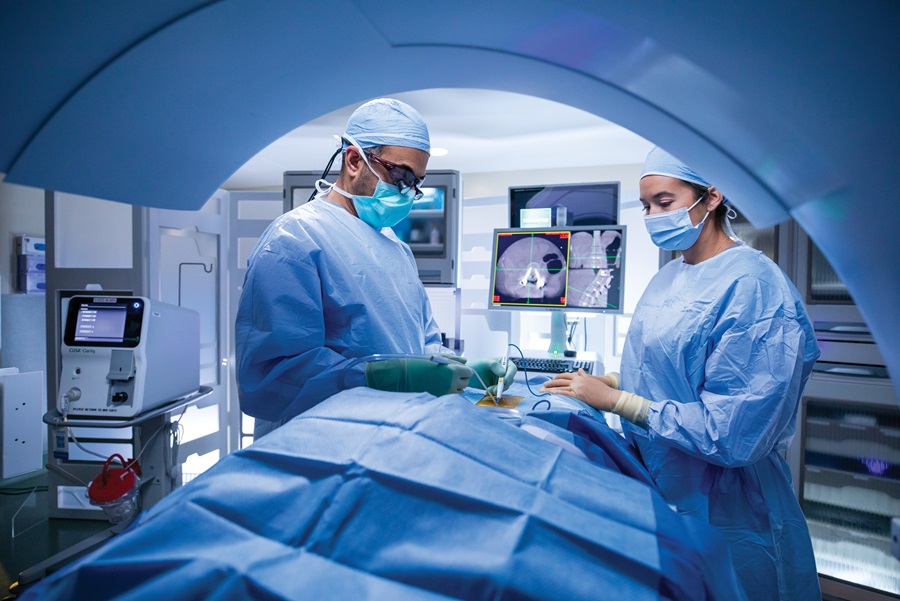An Overview of Spine Problems That Often Cause Surgical Treatments
Spine problems such as herniated discs, spine stenosis, and degenerative disc disease regularly require surgical treatments when conventional treatments fall short to relieve consistent symptoms. Recognizing the nuances of each condition and the matching surgical alternatives, such as discectomy or back fusion, is crucial for reliable administration.
Herniated Discs
Although numerous individuals with herniated discs may locate relief via conventional therapies, surgical procedure ends up being a necessary factor to consider when symptoms get worse or persist - best spine surgeons in st louis mo. A herniated disc happens when the soft internal gel of a spinal disc protrudes with its external layer, potentially compressing neighboring nerves and leading to pain, tingling, or weakness in the extremities
Conventional monitoring usually consists of physical therapy, pain medicines, and corticosteroid injections, which aim to minimize swelling and improve function. In instances where these methods fail to minimize devastating symptoms, surgical options may be checked out.
One of the most usual surgery for herniated discs is a discectomy, which includes the removal of the herniated part of the disc to soothe stress on the affected nerve root. In much more serious situations, spine blend might be essential to stabilize the affected vertebrae.
Patients are recommended to talk about the prospective dangers and benefits of surgical treatment with their doctor to make an educated choice. Inevitably, the objective of any kind of medical treatment is to bring back feature, relieve discomfort, and enhance general lifestyle for individuals experiencing herniated discs.
Spinal Stenosis
Spinal constriction takes place when the rooms within the spinal column narrow, causing enhanced pressure on the spinal cable and nerves. This problem can establish in various regions of the back, consisting of the lumbar and cervical areas, often as a result of age-related adjustments, such as degenerative disc illness, arthritis, or thickening of tendons.
Individuals with spine constriction might provide with symptoms that consist of pain, pins and needles, tingling, or weak point, mainly in the legs or arms. These signs and symptoms can be worsened by activities that entail standing or walking, frequently leading people to seek relief via conventional therapies like physical treatment, medications, or epidural steroid shots.
Nevertheless, when these non-surgical interventions fall short to offer adequate alleviation, surgical choices may be taken into consideration. Common procedures for back stenosis consist of laminectomy, which includes the elimination of part of the vertebra to alleviate stress, and spinal combination, which stabilizes the afflicted area. The choice to pursue surgical treatment is usually based upon the intensity of symptoms, the level of useful impairment, and the total health of the individual. Prompt diagnosis and monitoring are essential to protect against additional neurological concession and boost lifestyle.
Spondylolisthesis
Spondylolisthesis happens when one vertebra slides onward over another, leading to misalignment of the spinal column. This problem can arise from numerous factors, including hereditary flaws, injury, or degenerative adjustments in the back. It is most commonly observed in the lumbar region, particularly at the L4-L5 and L5-S1 levels.

Treatment alternatives differ based on the seriousness of the slippage and the symptoms offered. Conventional procedures, including physical treatment, discomfort administration, and activity alteration, are commonly the first line of protection. When non-surgical methods fail to soothe signs or when significant nerve compression is existing, surgical intervention might be required. Surgical alternatives can include back combination or decompression procedures, focused on restoring placement and minimizing neurological signs. Early diagnosis and proper management are crucial for optimum results in patients with spondylolisthesis.
Degenerative Disc Illness

The problem can be detected via a combination of professional analysis, imaging researches, and individual history. When these methods go to these guys fail to give appropriate relief, surgical treatments may be thought about.
Surgical choices for DDD may consist of spinal blend or synthetic disc substitute, focused on maintaining the impacted segment and easing pain (best spine surgeons in st louis mo). Inevitably, the choice of therapy is individualized, thinking about the severity of the problem, patient health and wellness, and lifestyle aspects
Spinal Growths

Spinal tumors can arise from various factors, including hereditary proneness, environmental influences, and pre-existing clinical conditions. People might present with an array of signs and symptoms, consisting of local see post pain, neurological deficiencies, weakness, or modifications in bowel and bladder function, depending on the lump's dimension and place.
Diagnosis normally includes imaging research studies such as MRI or CT scans, which help mark the growth's attributes and influence on surrounding frameworks. In examining treatment options, the lump's kind, grade, and area are essential factors to consider. Surgical intervention may be necessitated to ease symptoms, get a biopsy, or eliminate the tumor totally. The goal of surgical procedure is commonly to decompress neural components and support the back. Adjuvant therapies, consisting of radiation or radiation treatment, might likewise be necessary relying on the tumor's nature. Early discovery and intervention are vital for enhancing end results in clients with back tumors.
Verdict
In recap, spine conditions such as herniated discs, back constriction, spondylolisthesis, degenerative disc disease, and spine lumps frequently necessitate surgical treatment as a result of their potential to cause considerable discomfort and useful impairment. While conservative treatments may use short-lived alleviation, surgical options end up being important when signs and symptoms persist or intensify. Prompt medical diagnosis and treatment play an essential function in bring back function and improving the lifestyle for damaged people, emphasizing the relevance of thorough back treatment.
